This article is a follow up to the discussion of the role of surgical procedures, in this case suction assisted protein lipectomy (SAPL), as an additional treatment option for lymphedema. SAPL is a surgery technique to remove harmful inflammatory tissues present in stage 2 lymphedema and is different than standard liposuction. Other lymphedema surgeons have also described similar procedures.
Please keep in mind that any surgical approach to treat lymphedema should be reserved for those cases when conservative treatments have clearly been unsuccessful or when the achieved success of conservative measures can no longer be maintained.
SAPL presents a viable option for those patients when excess tissue following Complete Decongestive Therapy (CDT) cannot effectively be treated with conservative, non-surgical lymphedema therapy, a successful surgical treatment outcome depends largely on a close cooperation between the surgeon and a lymphedema therapist with specific experience with this procedure pre- and post-operatively.
I asked Dr, Jay W. Granzow, MD, MPH, FACS, a surgeon, lymphedema specialist and specialist in this procedure to comment:
Suction Assisted Protein Lipectomy (SAPL) For The Treatment Of Chronic Lymphedema
Jay W. Granzow, MD, MPH, FACS
www.lymphedemasurgeon.com
Suction Assisted Protein Lipectomy (SAPL) lymphedema surgery is a procedure that can effectively remove the excess solids that have accumulated in chronic lymphedema. In many patients, these lymphedema solids build up over time and cause an arm or leg to no longer be reducible to a normal size. The solids are permanent and cannot be effectively treated with conservative, non-surgical lymphedema therapy. In addition, lymphedema surgeries that best address fluid excess, such as Vascularized Lymph Node Transfer (VLNT) or Lymphaticovenous Anastomosis (LVA) cannot effectively address these solids.
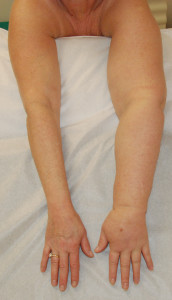
Patient with 7-year history of solid predominant lymphedema of the left arm following breast cancer treatment before SAPL surgery
SAPL surgery must be offered as part of a comprehensive treatment system that includes lymphedema therapy. The first step in treating patients with lymphedema solids is lymphedema therapy administered by an experienced lymphedema therapist to address any excess fluid component that may be present. Afterwards, SAPL surgery is performed to aspirate the fatty solids that cannot be removed with lymphedema therapy. These volume reductions are permanent with ongoing use of custom fitting compression garments following the surgery.
SAPL surgery also greatly reduces the risk of cellulitis, a type of infection that is particularly dangerous in lymphedema patients. This surgery has
been shown in the medical literature to reduce the risk of cellulitis infection over 80%.
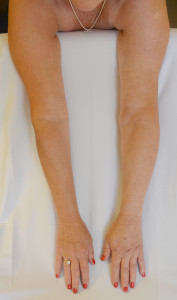
Same patient 28 months after SAPL and subsequent staged lymph node transfer surgery.
SAPL surgery has proven to be safe and there have been no reported cases of patients whose lymphatics have been damaged after the procedure. This has been confirmed by multiple studies published in the medical literature.(1) In fact, clinically, the lymphatic drainage appears to improve after SAPL surgery.
The surgical technique used in SAPL surgery is very different than cosmetic liposuction and should not be performed by lymphedema surgeons without significant training and experience with this technique.
The integration of individualized lymphedema therapy and compression garment use following SAPL surgery is critical in achieving and maintaining a good result. An average volume reduction of 111% in arms and 86% in legs has been reported
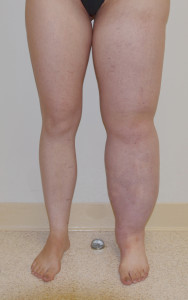
Patient with 17 year history of primary (congenital) solid predominant lymphedema of left leg before SAPL surgery
after SAPL surgery (2). Patients who are unable to maintain long-term compression post SAPL surgery are not good candidates for this surgery.
After a successful SAPL surgery, physiologic lymphedema surgeries such as VLNT or LVA may be used as staged surgeries at a later time to address the residual fluid component and reduce the amount of compression required to maintain the permanent volume reductions. (3)
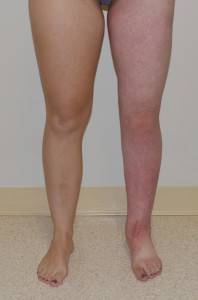
Same patient 10 months after SAPL surgery
Dear Lymphedema Blog Reader – if you like the contents on this website, please help to keep it going. A great amount of work and research is necessary to provide you with up-to-date information on this site. Your donation supports these efforts and associated administrative costs. Surplus funds will be donated to Lymphedema/Lipedema-related charitable endeavors. Please donate using the “Donate Now” button on the right upper hand of this page – Thank You!
Bibliography:
- Brorson H, Svensson H, Norrgren K, Thorsson O. Liposuction Reduces Arm Lymphedema Without Significantly Altering The Already Impaired Lymph Transport. Lymphology 31 (1998) 156-172.
- Granzow JW, Soderberg JM, Kaji AH, Dauphine C. An Effective System of Surgical Treatment of Lymphedema. Ann Surg Oncol. 2014 Apr;21(4):1189-94.
- Granzow JW, Soderberg JM, Dauphine C. A Novel Two-Stage Surgical Approach to Treat Chronic Lymphedema. Breast J. 2014 Jun 19.

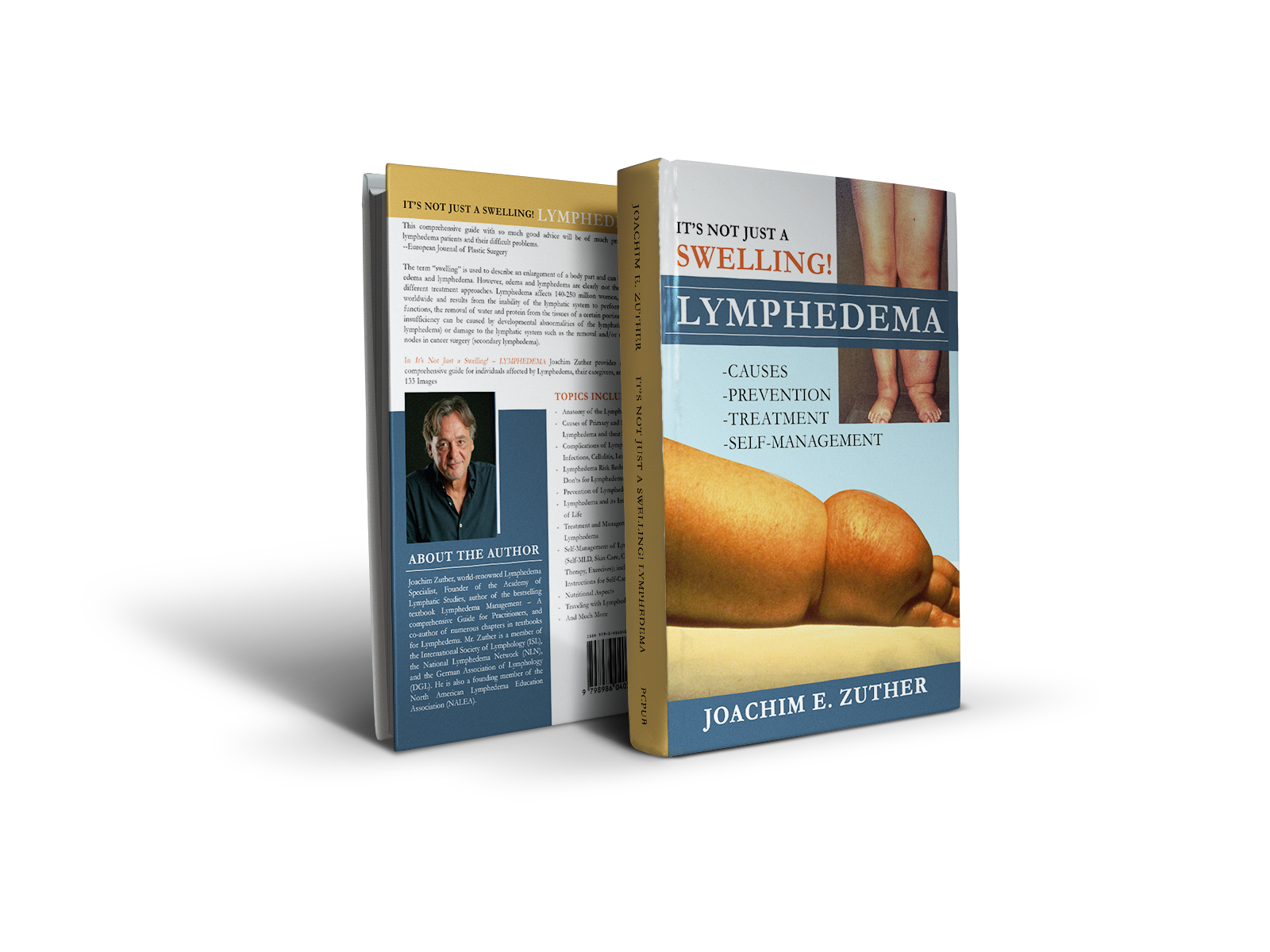
 Joachim Zuther, Lymphedema Specialist.
Joachim Zuther, Lymphedema Specialist. 

where can we have that done ,in quebec canada ,is it pay by the gouvernement , i know they save my life but its hard for me to find a man that doesnt care that i have a big arm please let me know
mr. zuther – my doc referred me to a physical therapist with lymphatic background. the therapist stated there was nothing she could do for me. she gave me paperwork for the NLN for a compression garment and devices. there is a growth on the inner thigh of the affected leg that is interfering with the ability to walk unassisted. there are few people in illinois with background in lymphedema. i’ve checked the websites. the other issue is healthcare companies willingness to pay for such procedures. any info would be welcome.
Are you diagnosed with lymphedema? There is a lymphedema specialist in Chicago, Dr. Joseph Feldman. You may get in contact with him. alternatively, you may seek the advice of another lymphedema therapist. You can use the link on top of this page labeled “Find a Therapist” to locate a lymphedema therapist in your area.
I saw Dr. Granzow. He spent a whole hour with me and took pictures, etc. He stated I did not have lymphedema. My original diagnosis was a combination of lymphedema and lipoeda (took many fat cells).
I am 88-years old and need help. I recently went to my vascular surgeon for help and he is attempting to help me.
Waiting for more advances in suction techniques as wearing a compression stocking 24/7 does not sound good